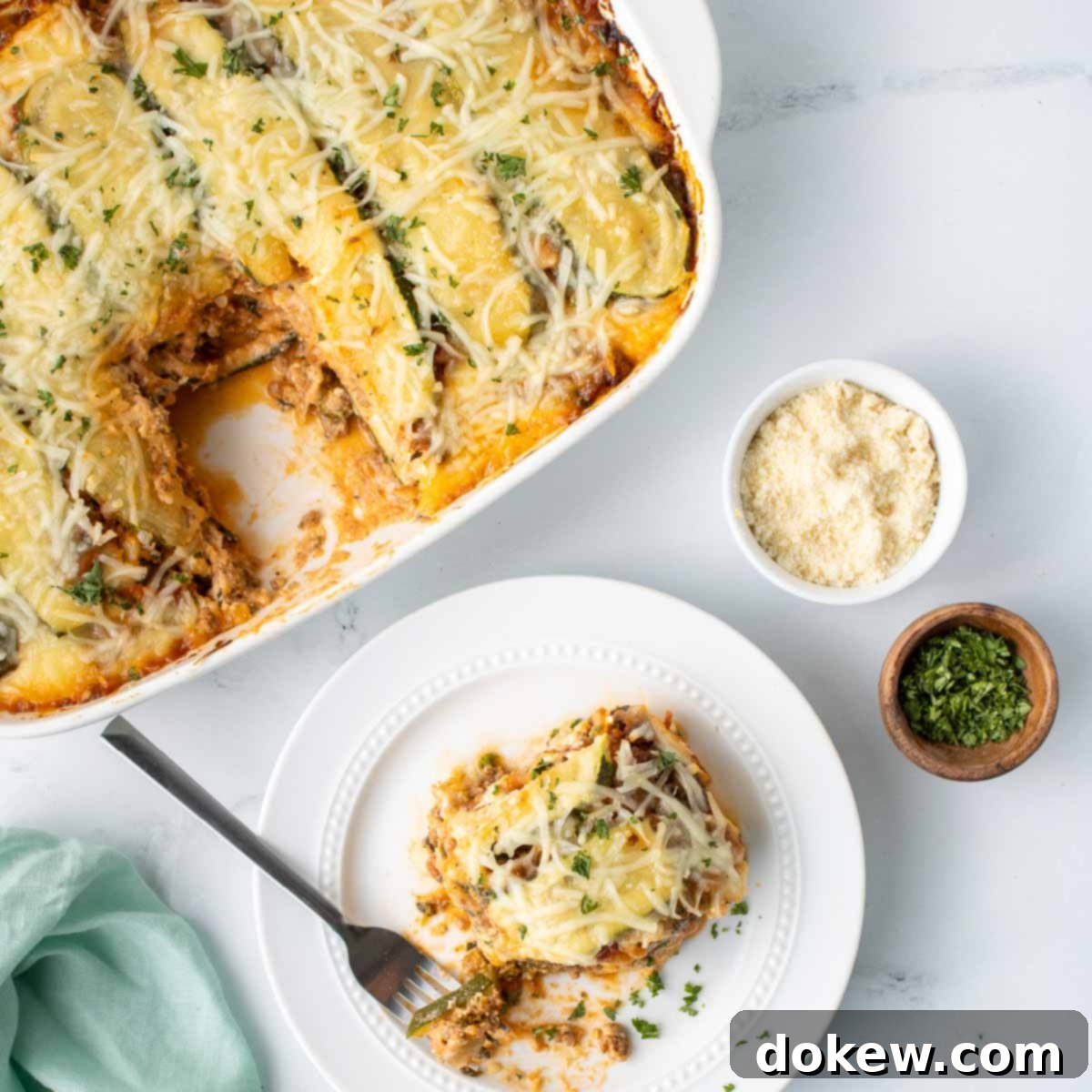The Ultimate Freezer Zucchini Lasagna Recipe: Delicious, Low-Carb & Meal Prep Friendly
Imagine a hearty, comforting lasagna that’s not only packed with flavor but also incredibly convenient for busy weeknights and healthy eating. This delicious freezer zucchini lasagna recipe offers just that, brimming with nutrient-rich vegetables and making excellent use of a bountiful zucchini harvest. Featuring layers of creamy ricotta cheese, a rich and savory meat and vegetable sauce, perfectly tender zucchini slices, and a generous topping of melted, bubbly cheese, this Freezer Zucchini Lasagna is a true crowd-pleaser that everyone will love.
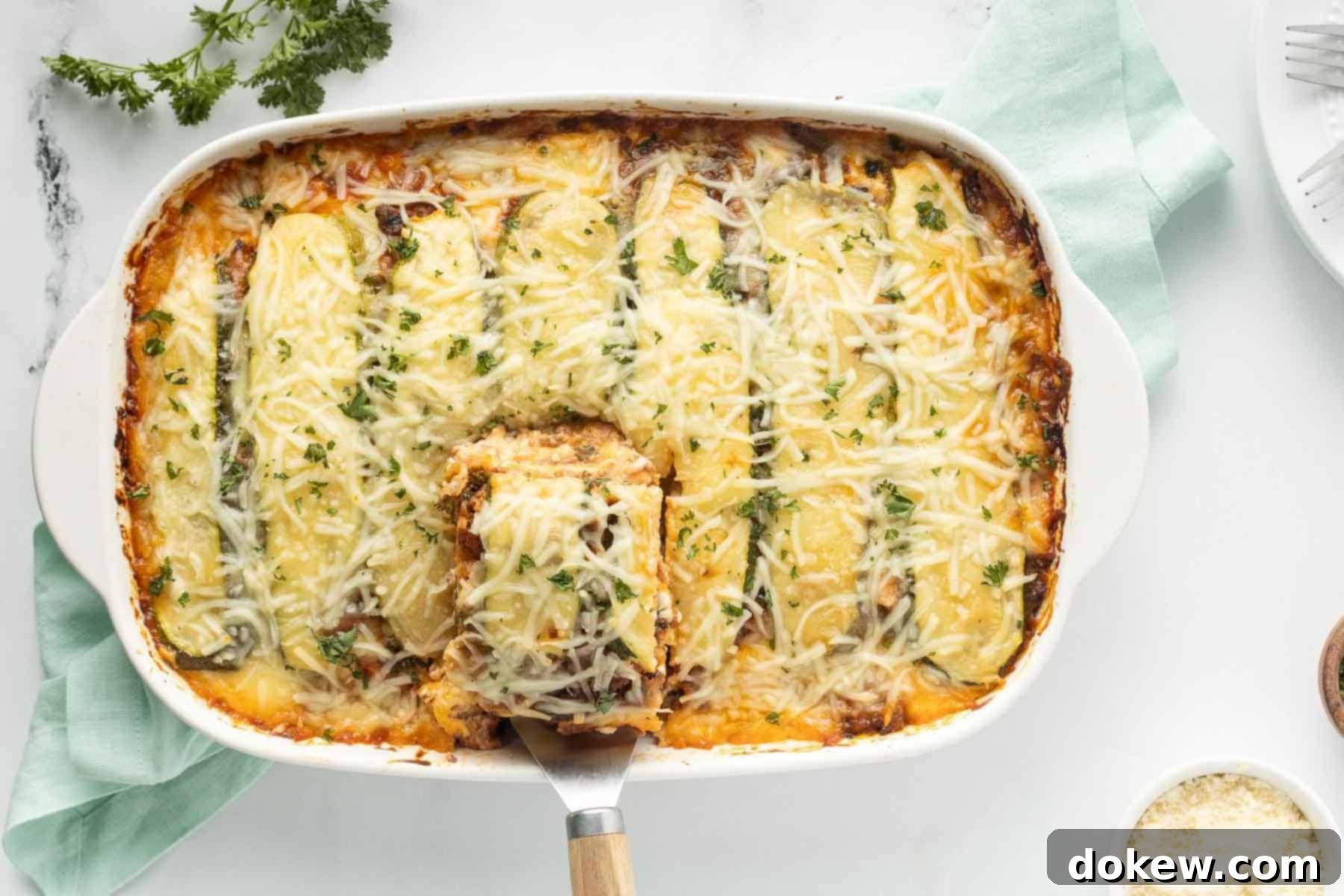
When your garden is overflowing with zucchini, or you simply find a great deal at the farmer’s market, this recipe is your golden ticket to preserving that freshness all year long. Zucchini is an incredibly versatile vegetable, offering a naturally low-carb alternative to traditional pasta noodles. This makes our zucchini lasagna an ideal choice for anyone looking to reduce carbohydrate intake without sacrificing taste or satisfaction.
Much like our popular freezer-friendly Zucchini Quiche, this lasagna is specifically designed to hold up beautifully in the freezer, making it a perfect candidate for meal prepping. The beauty of this recipe lies in its efficiency: by preparing one lasagna for tonight’s dinner and another for your freezer, you maximize your time and effort, ensuring you have a wholesome, homemade meal ready to go whenever hunger strikes.
This recipe transforms fresh zucchini into a delectable, satisfying dish that can be enjoyed immediately or saved for later, providing a convenient solution for meal planning and healthy eating. Whether you’re feeding a family or looking for convenient single-serve options, this freezer-friendly zucchini lasagna ensures you’ll always have a nutritious and delicious meal on hand.
[feast_advanced_jump_to]Watch the Recipe Video
For a visual guide to making this incredible freezer zucchini lasagna, check out our step-by-step video tutorial. It covers everything from preparing your zucchini to layering your ingredients and offers helpful tips to ensure your lasagna turns out perfectly every time.
Essential Ingredients for Freezer Zucchini Lasagna
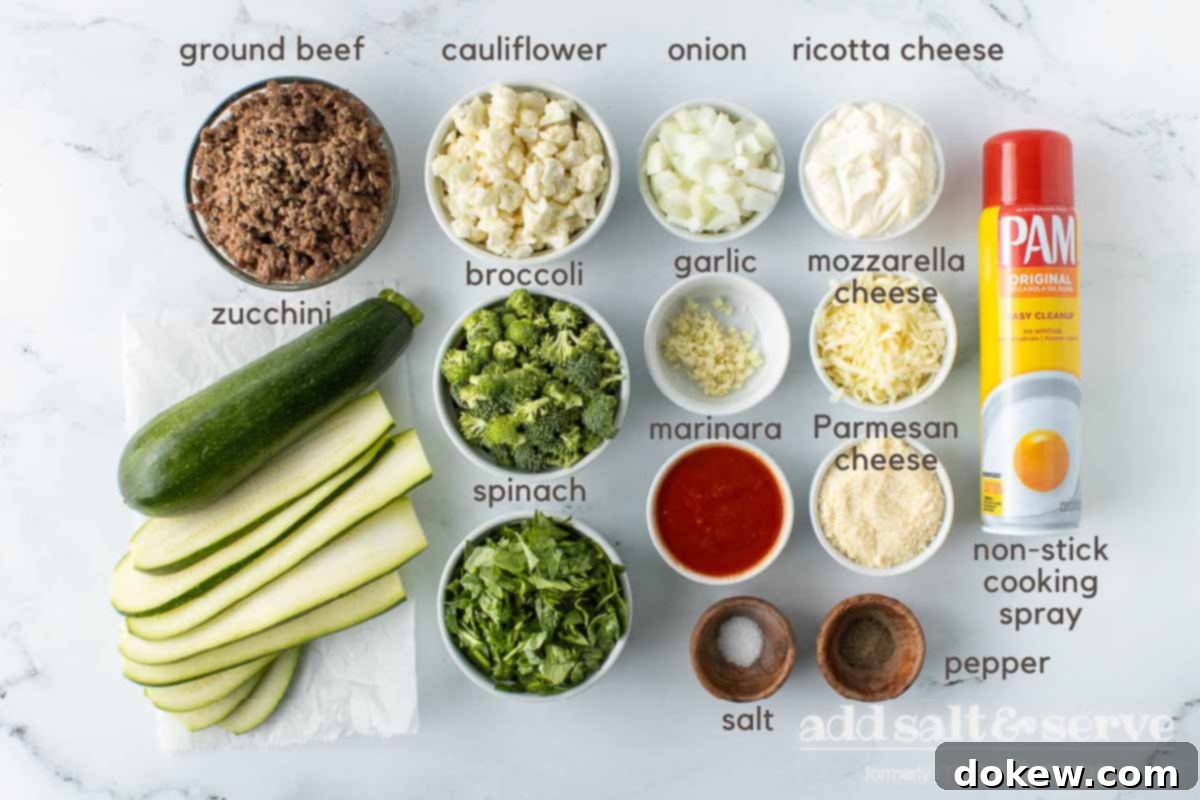
To create this wholesome and delicious zucchini lasagna, you’ll need a selection of fresh vegetables, flavorful sauces, and creamy cheeses. Each ingredient plays a vital role in building the robust flavor profile and comforting texture of this dish.
- Zucchini: The star of our low-carb “noodles.” Choose firm, medium-sized zucchini for the best texture.
- Ground Beef: Provides a hearty base for the meat sauce. Opt for lean ground beef for a healthier option.
- Onion: Adds a foundational aromatic flavor to the sauce.
- Broccoli: Boosts the nutritional content and adds a pleasant texture.
- Cauliflower: Another excellent vegetable for added nutrients and a subtle flavor.
- Spinach: Wilts into the sauce, providing iron and a vibrant green color. Fresh spinach is preferred.
- Garlic: Essential for its pungent, aromatic qualities that enhance all the other flavors.
- Salt & Pepper: Basic seasonings to bring out the best in your ingredients. Adjust to your personal taste.
- Marinara Sauce: The backbone of the lasagna’s savory depth. Choose a high-quality marinara with a low sugar content for a healthier profile.
- Ricotta Cheese: Creates the creamy, signature layer of traditional lasagna. Whole milk ricotta offers the richest texture.
- Parmesan Cheese: Adds a sharp, salty depth that complements the other cheeses.
- Mozzarella Cheese: For that irresistible, gooey, melted cheese layer that every lasagna needs. Shredded part-skim mozzarella works well.
- Non-stick Cooking Spray: To ensure easy removal and prevent sticking.
For precise measurements, please refer to the detailed recipe card below.
Selecting and Preparing Zucchini for Lasagna
Choosing the right zucchini is crucial for preventing a watery lasagna and ensuring a pleasant texture. Look for firm, medium-sized zucchini, typically 6-8 inches in length, that are free from blemishes, nicks, or cuts. Avoid overly large zucchini, as they tend to have a higher water content, larger seeds, and a less desirable, often stringy texture. Since this recipe calls for slicing the zucchini lengthwise to mimic lasagna noodles, aim for long, straight squash, which will be much easier to work with.
Proper preparation of zucchini is key to avoiding a soggy lasagna. Before slicing, store your zucchini in the refrigerator’s vegetable crisper drawer to maintain freshness. Wash the zucchini thoroughly just before use; there’s no need to peel it, as the skin adds nutrients, color, and helps the slices hold their shape. The most effective way to remove excess moisture from zucchini is to slice and bake it prior to assembly.
To prepare:
- Trim both ends of the zucchini.
- Using a sharp knife or, ideally, a mandoline slicer, carefully slice the zucchini lengthwise into thin, even strips, approximately ¼-inch thick. A mandoline ensures uniform thickness, which is important for even cooking and preventing some slices from being too soft while others are too firm.
- Lay the zucchini slices in a single layer on a parchment-lined baking sheet.
- Lightly sprinkle both sides of the slices with salt. The salt helps draw out moisture.
- Bake in a preheated oven (as specified in the recipe card) for about 10 minutes, flipping once halfway through. This par-baking step is vital for releasing a significant amount of the zucchini’s natural water content, which is the primary culprit behind watery lasagna.
- After baking, you may also gently blot the slices with paper towels to absorb any remaining surface moisture before assembling your lasagna. This extra step guarantees a firm, flavorful lasagna.
Crafting Your Freezer Zucchini Lasagna: Step-by-Step
Creating this flavorful and freezer-friendly zucchini lasagna is a rewarding process. Follow these steps for a perfectly layered and delicious meal.
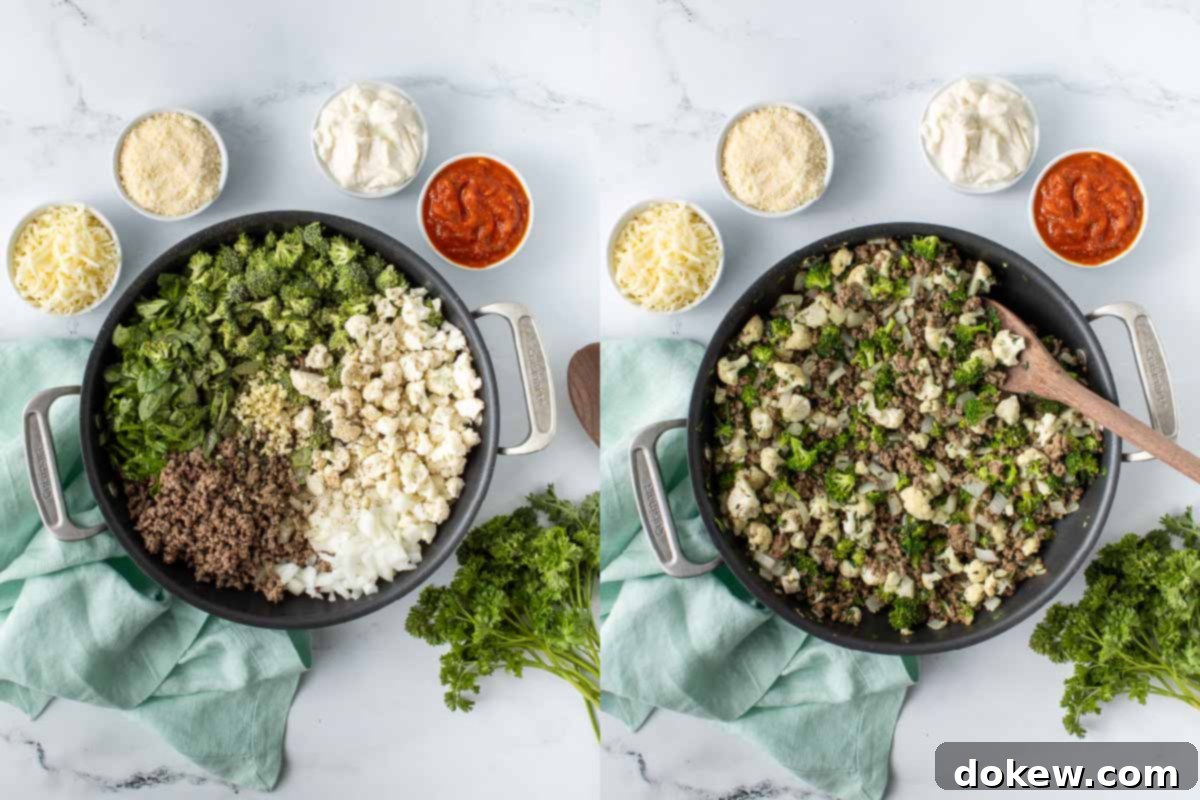
Begin by preheating your oven to 425°F (220°C). This higher temperature is for par-baking the zucchini, an essential step to remove excess moisture and prevent a watery lasagna. While the oven preheats, you can start preparing your ingredients to streamline the process.
First, cook your ground beef in a large skillet over medium-high heat until it’s fully browned and crumbled. Drain off any excess fat thoroughly to ensure your sauce isn’t greasy. While the beef is cooking, multitask by dicing the onion, chopping the broccoli and cauliflower into small, bite-sized pieces, and mincing the garlic cloves. Having all your vegetables prepped will make the cooking flow smoothly.
Once the ground beef is cooked and drained, add the diced onion, chopped broccoli, chopped cauliflower, fresh spinach, minced garlic, ½ teaspoon of salt, and a generous pinch of black pepper to the skillet. Sauté this mixture for approximately five minutes, stirring occasionally. The vegetables should soften slightly, and the spinach will begin to wilt. This step allows the flavors to meld beautifully before adding the marinara sauce.
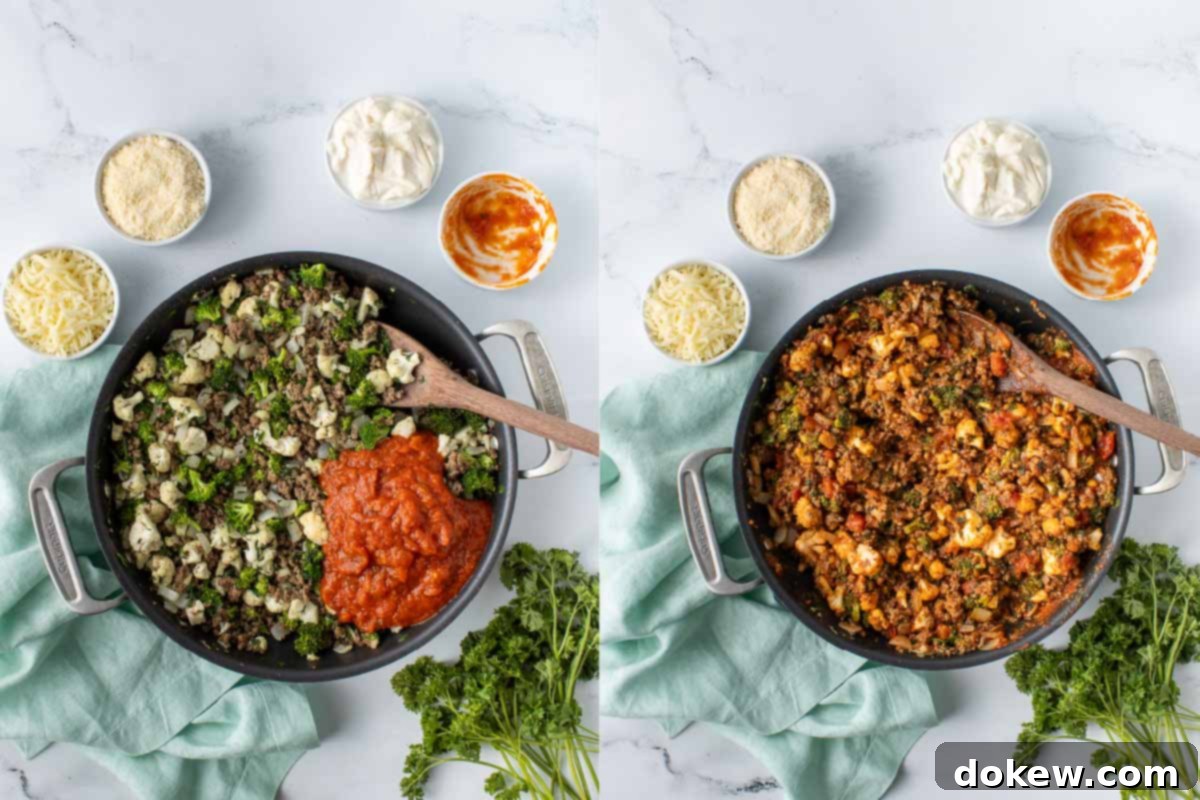
Now, pour the marinara sauce over your cooked meat and vegetable mixture in the skillet. Stir everything together until well combined. Allow the sauce to simmer gently for about 10 minutes, stirring occasionally. Simmering allows the flavors to deepen and ensures the vegetables are tender-crisp, not mushy. This rich, hearty sauce will be a cornerstone of your lasagna’s flavor.
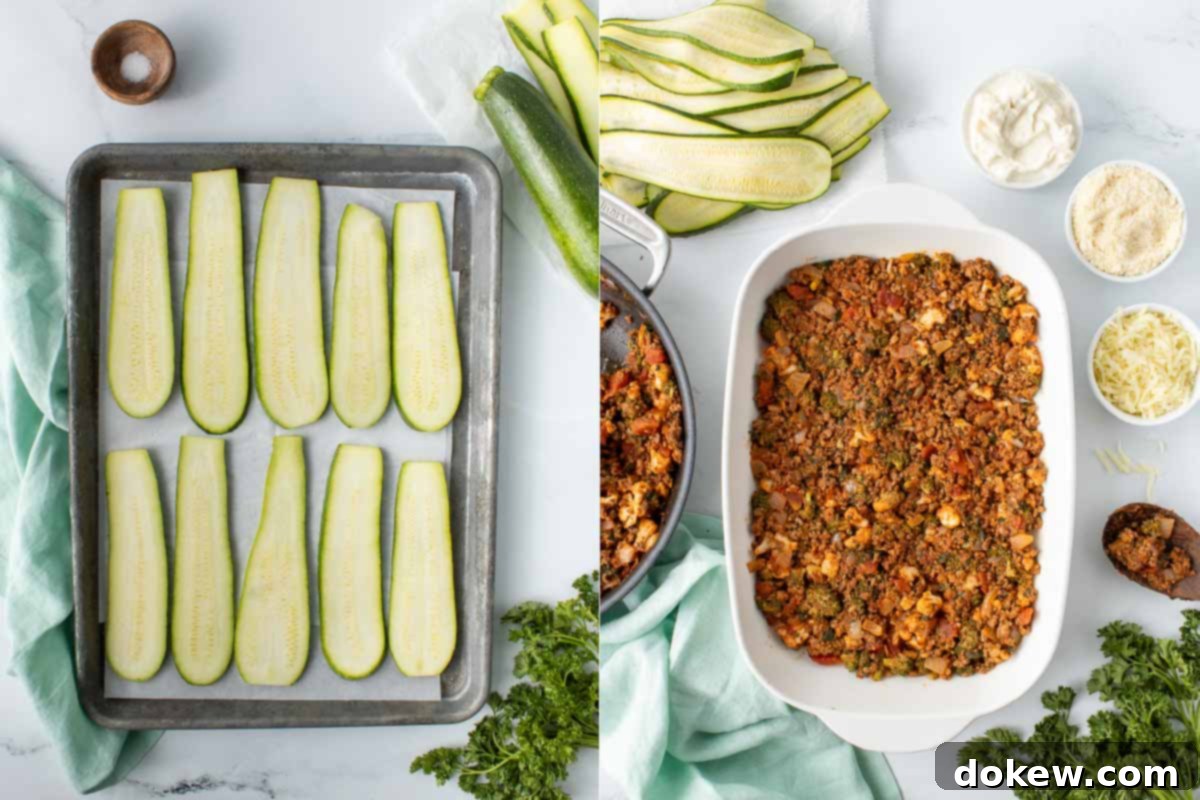
While your meat and vegetable sauce is simmering, it’s time to prepare your zucchini “noodles.” As mentioned earlier, this step is vital for preventing a watery lasagna. First, cut the stem off the zucchini, wash them thoroughly, and then slice them lengthwise into approximately ¼-inch thick strips. A mandoline slicer is highly recommended for achieving consistently even slices, which cook uniformly. However, a sharp knife can also be used with careful, steady hands.
Arrange the zucchini slices in a single layer on a parchment-lined cookie sheet. Sprinkle them lightly with salt. Bake these slices in the 425°F (220°C) oven for 10 minutes, flipping them once halfway through the baking time. This process draws out excess moisture, ensuring your lasagna maintains its structure. Once baked, remove the zucchini from the oven and reduce the oven temperature to 375°F (190°C) for the final lasagna bake.
After baking, you might notice some moisture on the zucchini slices. You can gently blot them with paper towels to absorb any remaining surface liquid before you begin assembling your lasagna. This small but significant step will make a big difference in the final texture of your dish.
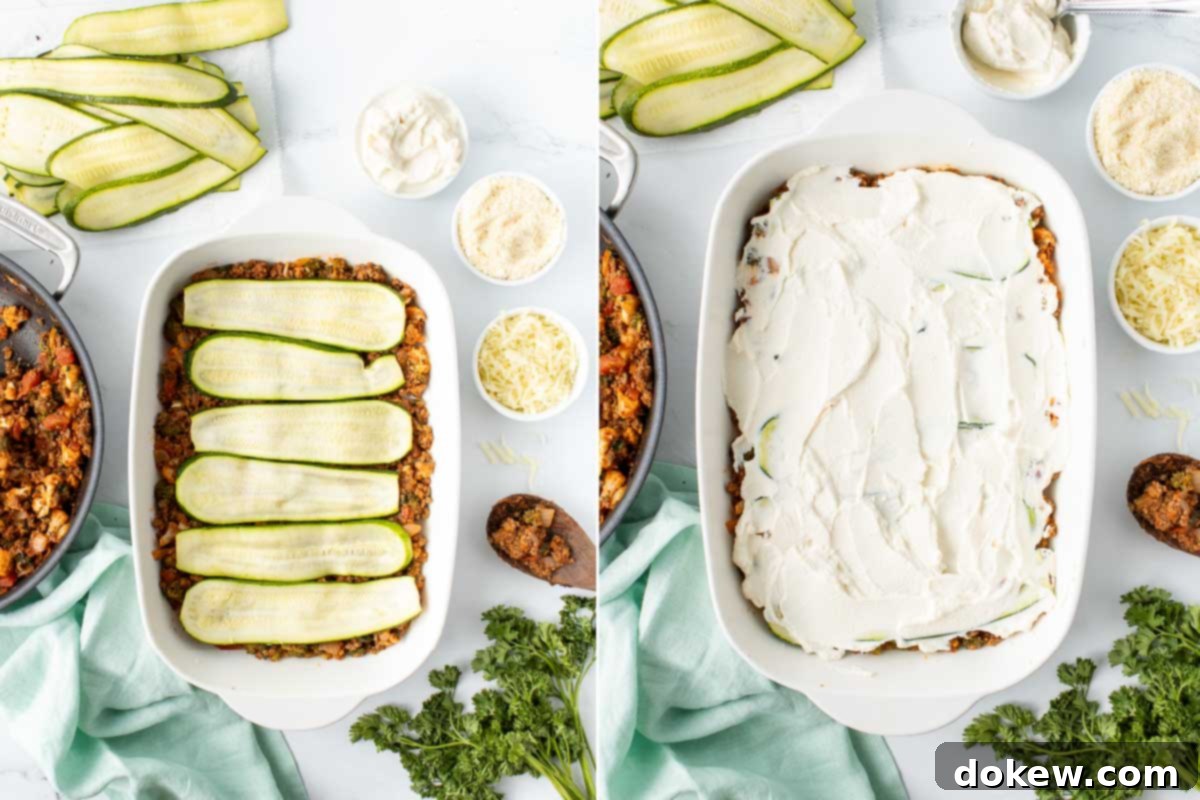
Now, for the exciting part: assembling your lasagna! Lightly spray a 9×13-inch baking dish with non-stick cooking spray. This will help prevent sticking and make serving easier. The layering process is similar to traditional lasagna, ensuring every bite is a perfect blend of flavors and textures.
Start by spreading ⅓ of your flavorful meat and vegetable sauce mixture evenly across the bottom of the prepared baking dish. This forms the base layer. Next, arrange ⅓ of the prepared zucchini slices over the sauce, overlapping them slightly if needed to cover the surface. On top of the zucchini, spread ½ of the 2 cups of creamy ricotta cheese. Then, sprinkle ⅓ of the 1 cup of grated Parmesan cheese, followed by ⅓ of the 1 cup of shredded mozzarella cheese. This completes your first full layer.
Repeat these layers once more: another ⅓ of the meat and vegetable sauce, followed by another ⅓ of the zucchini slices, the remaining half of the ricotta cheese, another ⅓ of the Parmesan cheese, and another ⅓ of the mozzarella cheese. Ensure each layer is spread evenly to distribute the flavors throughout the lasagna.
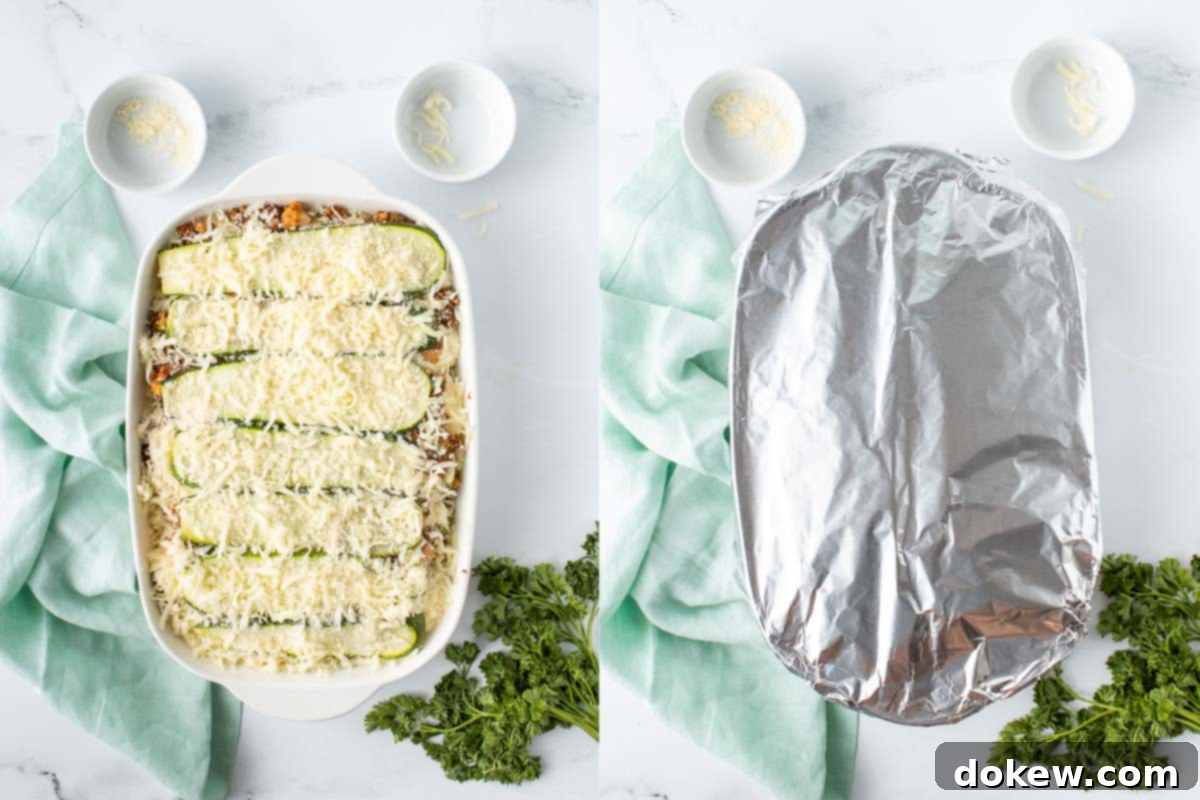
For the final, crowning layer of your magnificent lasagna, use the remaining meat and vegetable sauce mixture to cover the top. Then, carefully arrange the remaining zucchini slices over the sauce. Finally, generously sprinkle the rest of the Parmesan and mozzarella cheeses over everything. This top layer of cheese will melt into a golden, bubbly crust, creating an irresistible finish.
Cover the baking dish tightly with aluminum foil. Place it in your preheated 375°F (190°C) oven and bake for 45 minutes. The foil helps to steam the lasagna, ensuring even heating and preventing the top from browning too quickly. After 45 minutes, remove the foil and continue baking for another 10 minutes, or until the cheese is beautifully golden brown and bubbly, and the lasagna is heated through.
Once baked, remove the lasagna from the oven and let it sit for at least 10 minutes before slicing and serving. This resting period is crucial as it allows the layers to set, making it much easier to cut and serve neat portions without the lasagna falling apart.
Pro Tip for Meal Prep: This freezer zucchini lasagna is ideal for making ahead! You can prepare the lasagna up to the point of baking and store it in the refrigerator for up to 24 hours. For longer storage, freeze it for up to 6 months. If baking from the refrigerator, simply let the lasagna sit on the counter for about 30 minutes to come closer to room temperature before baking as instructed. For baking from frozen, refer to the detailed freezer instructions below.
Versatile Substitutions for Your Zucchini Lasagna
One of the many great qualities of this zucchini lasagna recipe is its adaptability. It’s easy to customize to fit various dietary needs and preferences without compromising on flavor or texture. Here are some popular substitutions:
- Naturally Gluten-Free: This recipe inherently uses zucchini slices as the “noodles” instead of traditional pasta, making it naturally gluten-free. There’s no need for special adjustments if you’re avoiding gluten.
- Low Carb Friendly: With zucchini replacing high-carb pasta, this dish is already a fantastic low-carb zucchini lasagna option. To ensure the lowest carb count, pay attention to your marinara sauce choice; opt for brands with minimal added sugars.
- Delicious Vegetarian Option: To transform this into a hearty vegetarian lasagna, simply omit the ground beef. You can enhance the richness and protein content by adding extra vegetables like mushrooms or bell peppers, or by incorporating a plant-based protein alternative such as cooked lentils or a meatless ground substitute into the marinara sauce.
- Alpha-Gal Syndrome Adaptations: For those managing Alpha-gal syndrome, the vegetarian version is an excellent choice. Alternatively, you can substitute the ground beef with ground turkey or chicken. If dairy products are also an issue, consider using plant-based ricotta and mozzarella alternatives, which are widely available in most grocery stores. Ensure all other ingredients, like marinara sauce, are free from mammal products.
- Other Vegetable Additions: Feel free to experiment with other vegetables. Diced carrots, bell peppers, mushrooms, or even finely chopped kale can be added to the meat sauce for extra flavor and nutrients. Just be mindful of vegetables with high water content, and pre-cook them if necessary to prevent a watery lasagna.
These substitutions allow you to enjoy this comforting lasagna while adhering to your specific dietary requirements, proving its versatility as a staple recipe.
Storage & Freezer Instructions for Zucchini Lasagna
Proper storage is essential to maintain the freshness and quality of your zucchini lasagna, especially when preparing it for the freezer.
For immediate consumption, store any leftover lasagna in an airtight container in the refrigerator for up to 4 days. This ensures it remains delicious and safe to eat for several meals after preparation.
Freezing Your Lasagna (Cooked vs. Uncooked): The great news about this zucchini lasagna is that you don’t necessarily need to cook it first before freezing! Since all the ingredients (meat, sauce, and par-baked zucchini) are already cooked before assembly, you can freeze the lasagna directly after it’s assembled. Freezing it uncooked can sometimes result in a fresher taste upon reheating, as it bakes for the first time when you’re ready to eat it.
To Freeze the Assembled Lasagna: If you plan to freeze the entire lasagna in its baking dish, ensure the dish is freezer-safe. For easier storage and portioning, you might consider assembling the lasagna in disposable foil pans. This eliminates the need to tie up your permanent bakeware in the freezer.
- Once assembled, allow the lasagna to cool completely if it has been partially baked or if you’re using warm components.
- Wrap the lasagna tightly first with a layer of plastic wrap, ensuring it’s well-sealed to prevent freezer burn.
- Follow with at least one layer of heavy-duty aluminum foil, sealing it securely around the edges of the dish. This double-layer protection is crucial for long-term freezer storage.
- Label the foil with the dish’s name (“Freezer Zucchini Lasagna”) and the date it was prepared. This helps you keep track of its freshness.
Reheating Frozen Lasagna: When you’re ready to enjoy your frozen lasagna, there are a couple of ways to reheat it:
Freezer Zucchini Lasagna Date____________________
Reheat at 350ºF for 50+ minutes from frozen or 25-30 minutes from thawed until it reaches an internal temperature of 165ºF. If you prefer more browning, remove the foil for the last 10-15 minutes.
For the best results and food safety, always ensure the lasagna reaches an internal temperature of 165°F (74°C) before serving. Use a food thermometer inserted into the center of the lasagna to check.
Frequently Asked Questions About Zucchini Lasagna
How do you prevent zucchini lasagna from becoming watery?
Watery lasagna is a common concern when using vegetables with high water content like zucchini. The key is to reduce this moisture before assembling the dish. Our primary method involves slicing the zucchini thinly and par-baking it on a parchment-lined cookie sheet for about 10 minutes, flipping once. This crucial step draws out a significant amount of water, which is then evaporated in the oven.
Another effective technique, if you prefer not to bake, is to slice the zucchini, lay it in a colander, and sprinkle generously with salt. Let the slices sit for an hour or two over a bowl to catch the liquid. The salt helps draw out moisture through osmosis. After salting, rinse the zucchini thoroughly to remove excess salt and pat it very dry with paper towels before use. Regardless of the method, adequately preparing the zucchini is the most important step.
Furthermore, ensure that any other high-water-content vegetables you add, such as mushrooms or spinach, are also properly cooked and drained before being mixed into the sauce. Finally, using a thicker marinara sauce rather than watery canned tomatoes or tomato sauce will also contribute to a firmer, less watery lasagna.
Can you freeze zucchini lasagna, and for how long?
Absolutely! Zucchini lasagna freezes exceptionally well, making it a perfect dish for meal prepping. You can freeze it for up to six months. The beauty of this recipe is that you don’t need to cook it after assembly before freezing, as all the individual components (meat, sauce, and zucchini) are already cooked. This means you can assemble the lasagna, wrap it tightly, and pop it directly into the freezer.
To ensure optimal freshness and prevent freezer burn, wrap the assembled lasagna securely with two layers of plastic wrap, followed by a tight layer of heavy-duty aluminum foil. Don’t forget to label it clearly with “Freezer Zucchini Lasagna” and the date of preparation, along with reheating instructions. This preparation ensures you have a delicious, ready-to-bake meal for whenever you need it.
What’s the best way to cook zucchini lasagna from frozen?
Cooking a frozen zucchini lasagna is simple and convenient. For the best results, we recommend baking it from frozen, which helps maintain its structure and prevents overcooking.
Preheat your oven to 350°F (175°C). Remove the plastic wrap but keep the aluminum foil on. Place the foil-covered frozen lasagna directly into the preheated oven. Bake for approximately 50 to 60 minutes, or until the internal temperature reaches 165°F (74°C) when measured in the center with a food thermometer.
If you prefer a golden-brown and bubbly top, remove the foil for the last 10-15 minutes of baking. If you have time, you can also thaw the lasagna in the refrigerator overnight before baking; in this case, it will bake faster, typically needing only 25-30 minutes at 375°F (190°C) as per the initial baking instructions. Always ensure it’s fully heated through before serving.
Can I prepare zucchini lasagna in advance if I don’t want to freeze it?
Yes, absolutely! Zucchini lasagna is an excellent meal to prepare ahead of time, even if you don’t intend to freeze it. You can assemble the entire lasagna, up to the point of baking, and store it covered tightly in the refrigerator for up to 24 hours. This makes it a fantastic option for entertaining or for busy days when you want to minimize last-minute cooking.
When you’re ready to bake, simply remove the lasagna from the refrigerator about 30 minutes before baking to allow it to come closer to room temperature. Then, bake as instructed in the recipe: covered with foil for 45 minutes, then uncovered for 10 minutes, or until hot and bubbly with golden cheese on top.
Full Recipe Details
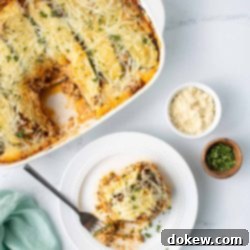
Freezer Zucchini Lasagna
Ingredients
- 4 medium zucchini, sliced lengthwise ¼-inch thick
- ½ teaspoon salt (plus extra for zucchini)
- 1 pound cooked ground beef (or ground turkey/chicken for Alpha-gal)
- 1 small onion, diced
- 2 cups broccoli, chopped
- 2 cups cauliflower, chopped
- 2 cups fresh spinach
- 2 cloves garlic, minced
- black pepper to taste
- 24 ounces marinara sauce (low sugar if possible)
- 2 cups ricotta cheese (whole milk preferred)
- 1 cup grated Parmesan cheese
- 1 cup shredded mozzarella cheese
- non-stick cooking spray
Instructions
- Preheat your oven to 425°F (220°C). This initial higher temperature is for par-baking the zucchini to remove excess moisture.
- In a large skillet, cook 1 pound ground beef until thoroughly browned and crumbled. Drain off all excess fat and set the cooked beef aside.
- Prepare your zucchini: Wash and trim the ends off the 4 zucchini. Slice them lengthwise into uniform ¼-inch thick strips using a sharp knife or mandoline.
- While the zucchini bakes, dice 1 small onion, chop 2 cups broccoli and 2 cups cauliflower into small florets, and mince 2 cloves garlic. Have your 2 cups fresh spinach ready.
- Arrange the prepared zucchini slices in a single layer on a parchment-lined cookie sheet. Sprinkle lightly with salt. Bake for 10 minutes, flipping the slices once halfway through the bake time to ensure even moisture removal.
- Remove the zucchini from the oven. Gently blot excess moisture with paper towels if needed. Reduce the oven temperature to 375°F (190°C) for the main baking of the lasagna.
- In the same large skillet (or a clean one), combine the cooked ground beef, diced onion, chopped broccoli, chopped cauliflower, fresh spinach, minced garlic, ½ teaspoon salt, and pepper to taste. Sauté for about five minutes, stirring frequently, until vegetables are slightly tender and spinach is wilted.
- Pour 24 ounces marinara sauce into the meat and vegetable mixture. Stir well and simmer for 10 minutes, stirring occasionally, allowing the flavors to deepen.
- Prepare a 9×13-inch baking dish by lightly spraying it with non-stick cooking spray. Begin assembling your lasagna with the following layers: spread ⅓ of the meat/sauce mixture, followed by a layer of ⅓ of the par-baked zucchini slices, then ½ of the 2 cups ricotta cheese, ⅓ of the 1 cup grated Parmesan cheese, and ⅓ of the 1 cup shredded mozzarella cheese.
- Repeat the layering sequence once more: ⅓ of the meat/sauce mixture, ⅓ of the zucchini slices, the remaining ricotta cheese, another ⅓ of the Parmesan cheese, and another ⅓ of the mozzarella cheese.
- For the final layer, use the remainder of the sauce mix, the rest of the zucchini slices, and then generously top with the remaining Parmesan and mozzarella cheeses.
- Cover the baking dish tightly with aluminum foil and bake for 45 minutes in the 375°F (190°C) oven. Remove the foil and bake for an additional 10 minutes, or until the cheese is golden and bubbly. Let the lasagna rest for 10 minutes before slicing and serving to allow the layers to set properly.
Notes
Nutrition per serving
This recipe is an adaptation from the delightful Zucchini Lasagna at Dashing Dish, a true inspiration for healthy, low-carb cooking. We hope you enjoy this freezer-friendly version as much as we do!
